Lately, a steadily growing list of local colleges are choosing to throw out their initial plans for the fall semester in favor of more cautious ones. Last week, it was American University, Georgetown University and George Washington University, and on Thursday, Loyola University and Johns Hopkins University became the latest to join the trend.
But at a virtual town hall Thursday, University System of Maryland Chancellor Jay Perman buckled down on what has been his message since late July: system universities should reopen for in-person classes at the start of their academic years. Still, he noted that each school is finalizing plans to reverse course should a major outbreak occur on its campus.
Perman addressed the university system’s role in managing the coronavirus pandemic as a guest on “Virtual Face to Face With Dr. Bruce Jarrell,” an interview series hosted by University of Maryland, Baltimore President Bruce Jarrell.
Though he acknowledged that the debate over the in-person versus online reopening of colleges and universities is controversial, Perman reiterated a statement he made to the Board of Regents in late July, arguing that students “need the campus environment as much as they need our courses.”
Students whose safety is jeopardized at home, and those who have nowhere else to go, rely on an on-campus environment to help them stay in school and succeed academically, he wrote in his July 22 statement.
But during the event, Perman took on a cautious tone when addressing the possibility of an outbreak on campus. All 12 institutions within the university system — comprising more than 210,000 students, faculty and staff — are partially reopening their campuses this fall after shutting down in March at the onset of the coronavirus pandemic in the U.S.
[USM joins lawsuit against ICE over new student visa rule]
Though 92 percent of undergraduate course sections at the University of Maryland will be taught at least partially online, the campus itself is situated in Prince George’s County, one of the state counties hardest-hit by the virus. Prince George’s has seen 160 daily cases, on average, for the past two weeks, and 748 deaths total since the outbreak began.
Perman said he is sensitive to the fact the county has faced the brunt of the COVID-19 crisis in Maryland and added that the virus itself has the final say in dictating whether it’s safe for students to remain on campus.
“Each institution in the system is finalizing, and I would hate to use this term, but it’s accurate, the ‘exit strategy’ that we’re going to have to take if we find that what we’re doing is not in the best interest at any point in time, of faculty, staff students and the community,” Perman said.
“Nothing is risk-free, there’s no such thing as no risk. We know that we need to be prepared. And that is the requirement for each university in the system,” he added.
Last week, the system announced that all students and employees returning to its institutions in-person this fall must be tested for the coronavirus within 14 days prior to their arrival. Confirmation of a negative test result must be sent to university officials, while those who test positive will not be permitted on the campus until they comply with a required period of isolation.
Additionally, the system announced, all returning students and employees must start daily symptom monitoring and reporting two weeks before they arrive on the campus.
Individual universities are tasked with enforcing these guidelines. Though the University of Maryland has not yet released guidance relating to these new rules, it has held two testing drives in recent weeks to monitor campus conditions.
In a July 20 campuswide email, Student Affairs Vice President Patty Perillo announced the university will offer voluntary testing for all members of the campus community.
[UMD makes SAT, ACT scores optional, citing testing barriers due to COVID-19]
In anticipation of a partial reopening, Maryland has also launched the “4Maryland” campaign, which emphasizes four guidelines to stop the spread of the coronavirus on the campus: wearing a face covering, maintaining social distance, washing hands frequently and staying home when sick.
Students will have to watch an “educational training video” on these guidelines before returning to the campus.
It is up to students if the system’s reopening is successful, Perman said. The onus is on them to stay six feet apart when they return, despite the tendency to want to socialize with peers after months apart.
Each president will enforce a code of conduct to help ensure that students follow social distancing rules, and Perman has instructed them not to be lenient in doing so, he said.
“They’re the ones, in addition to the faculty and staff, that have to be wearing the mask and social distancing, and not having inappropriate parties, and not having inappropriate activities off-campus that bust this all up,” he said. “You don’t follow the rules, you can’t come on campus. It’s as blunt as that.”
Last week, Prince George’s County Executive Angela Alsobrooks announced a new 50-person limit on gatherings in the county amid an uptick in COVID-19 cases. Previously, a maximum of 100 people were allowed to come together for social gatherings.
At the College Park city council meeting Tuesday night, College Park Mayor Patrick Wojahn reminded residents that those who knowingly violate the order could receive a $5,000 fine. Students who violate the order will also be referred to the university’s Office of Student Conduct, said Suellen Ferguson, the city’s attorney.



